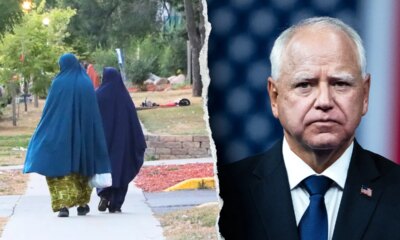Nevada
In Las Vegas, Kamala Harris sees a chance to improve her odds of winning
LAS VEGAS (AP) — Vice President Kamala Harris is working to make Nevada look like less of a political gamble in November’s election.
The Democratic presidential nominee visits the state on Saturday with her running mate, Minnesota Gov. Tim Walz. It’s the final stop of a battleground blitz in which Democrats are showing new energy after President Joe Biden exited the race and Harris replaced him at the top of the ticket. That new enthusiasm has enabled them to boost turnout efforts in swing states such as Nevada and Arizona, which Harris visited Friday.
Magnolia Magat, a 59-year-old restaurant owner in Las Vegas who lives in the neighboring city of Henderson, said she’s now “more hopeful” about the election.
“I am very happy that not only is our candidate a woman, she is Black and she’s also Asian,” said Magat, who is Filipino American. “And it’s not because Harris is a woman that I want to endorse her. It’s because she’s highly capable of running the country.”
As part of the trip, Harris is hoping to build greater support among Latino voters. In 2020, Biden narrowly beat Republican Donald Trump by 2.4 percentage points in Nevada. Trump, the former president, is trying this time to create more support in a state that relies on the hotel, restaurant and entertainment industry by pledging to make workers’ tips tax-free.
But the union representing 60,000 workers in that industry, the Culinary Workers Union, announced Friday night its endorsement of Harris. About 54% of the union’s members are Latino, 55% women and 60% immigrants.
“The path to victory runs through Nevada,” the union said in a statement, “and the Culinary Union will deliver Nevada for President Kamala Harris and Vice President Tim Walz.”
AP VoteCast found in 2020 that 14% of Nevada voters were Hispanic, with Biden winning 54% of their votes. His margin with Hispanic voters was slightly better nationwide, a sign that Democrats cannot take this bloc of voters for granted.
Harris is hoping to drive a wedge with Republicans by focusing on issues such as access to abortion and repairs to the U.S. immigration system. Her message is that Trump killed a bipartisan deal this year to improve security on the southern border and address immigration issues, with Democrats saying he did so in hopes of improving his own political odds.
Because Harris’ portfolio in the Biden administration included the root causes of migration and due to some of her comments before the 2020 election, Republicans have sought to portray her as weak on the southern border and enabling illegal immigration.
At a Thursday news conference, Trump said of Harris, “As a border czar, she’s been the worst border czar in history, in the world history.”
The Republican has proposed mass deportations if he returns to the White House, but AP VoteCast found in 2020 that nearly 7 in 10 Nevada voters said that immigrants living in the United States illegally should be offered the chance to apply for legal status.
Harris and Walz over the past week have also visited the crucial midwestern “blue wall” states of Pennsylvania, Wisconsin and Michigan. Along with Nevada and Arizona, those five states represent 61 electoral votes that could be essential for reaching the 270 threshold required to win November’s election. Harris had also planned to visit North Carolina and Georgia this past week — between them another 32 electoral votes — but those stops were postponed due to Tropical Storm Debby.
In Nevada’s rural Douglas County near the California border, Gail Scott, 71, serves on the central committee of the local Democratic Party and said she didn’t initially agree with calls for Biden to leave the race. Trump won the county in 2016 and 2020, but trimming his margins there could lower his ability to compete in Nevada.
What to know about the 2024 Election
Scott said it’s impossible to miss the energy that Harris has created among younger voters who could help statewide.
“Young people are embracing Kamala Harris and the enthusiasm and the joy that she’s brought to the campaign,” she said.
Brian Shaw, a Republican from northern Nevada, said Harris’ arrival on the top of the ticket could make it harder for Trump to win because Biden was a “pitiful candidate” and there’s little time to expose the vice president’s “incompetence.” He said he attended Republican vice presidential nominee JD Vance’s rally in Reno on July 30 and found him to be “likable, capable, polished as a politician, but not veneered.” He didn’t have much of an opinion of Walz.
___
Boak reported from Washington. AP writer Scott Sonner contributed to this report from Reno, Nevada.

Nevada
Police: Deadly crash closes all lanes at I-15, Charleston

LAS VEGAS (FOX5) — A deadly crash has closed all lanes at I-15 and Charleston Boulevard, police say.
Nevada State Police posted on social media after 7 p.m. about the crash. Police say drivers in the area should use other routes.
Police have not immediately shared details about the victim or if other people are involved. It’s not yet confirmed if impairment is suspected.
This is a developing story. Check back later for details.
Copyright 2025 KVVU. All rights reserved.
Nevada
Top Interior Department official has ties to Thacker Pass lithium mine – High Country News

This story was co-published with Public Domain.
Karen Budd-Falen, a top official at the Department of Interior, has financial ties to the controversial Thacker Pass lithium mine in northern Nevada — a project that the Trump administration worked to fast-track during its first term. In recent months, the administration took an equity stake in the mine and the mine’s parent company.
After an unexplained delay, Public Domain and High Country News obtained Budd-Falen’s financial disclosure earlier this month, which details her family’s extensive land holdings. Among them is Home Ranch LLC, a Nevada ranching operation valued at over $1 million. Nevada’s business search database shows a Home Ranch LLC that listed Frank Falen as the manager in February 2022. Frank Falen is also the name of Karen Budd Falen’s husband.
In November 2018, not long after Karen Budd-Falen joined the first Trump administration as a top legal official at the Interior Department, Home Ranch LLC agreed to sell water rights to Lithium Nevada Corporation, the company developing the Thacker Pass mine, for an undisclosed amount of money, according to a Securities and Exchange Commission filing. Frank Falen is listed on the document.
A Home Ranch also appears in planning documents that Lithium Nevada submitted to federal regulators during Trump’s first term. A monitoring plan for Thacker Pass, dated July 2021, notes that the company intended to use existing stock water wells owned by Home Ranch LLC to “monitor potential drawdown impacts” from its mining operations.
The water purchase agreement and other records raise questions about potential conflicts of interest. Budd-Falen was appointed in March as associate deputy secretary to Interior Secretary Doug Burgum — a position that does not require Senate confirmation. She also served as a high-ranking legal official at the Interior Department during President Trump’s first term.
It was during that earlier government stint that her official calendar lists a November 6, 2019 meeting in which Budd-Falen was scheduled to have “lunch with Lithium Nevada.”

In 2019, Lithium Nevada, a subsidiary of the Canadian mining firm Lithium Americas, was seeking speedy approval for its Thacker Pass mine in northern Nevada. In the waning days of the first Trump administration it received just that. In January 2021, the Bureau of Land Management approved the mine project, which includes some 5,700 acres of public land.
The $2.2 billion, open-pit mine project has drawn fierce opposition from area tribes and environmentalists, who argue it threatens water resources, endangered species and sacred cultural sites. Thacker Pass, known as Peehee Mu’huh to the Paiute Shoshone people, was the site of an 1865 massacre of at least 31 Paiute people.
Budd-Falen was being considered to lead the BLM during Trump’s first term, but turned down the director job when she learned that she and her husband would have to sell their interests in their family ranches to avoid conflicts of interest, she told The Fence Post in 2018.
Since returning to power, Trump and his team have again worked to move the project forward, as part of a broader push to boost critical mineral mining in the U.S. In September, the Trump administration struck a deal with Lithium Americas to take a 5% equity stake in both the Thacker Pass mine and the company, in exchange for the release of loan money from the Department of Energy.
Budd-Falen has largely worked behind the scenes at the Interior Department. Little is known about what issues she has focused on since returning to the sprawling agency. Notably, Interior officials have yet to release her ethics agreement, which would detail any companies or projects that are off limits.
“Did she have any oversight of the environmental review process regarding Thacker Pass? It is a big question,” said Kyle Roerink, executive director of the Great Basin Water Network, a water conservation group in Nevada. “If she didn’t recuse herself, it would fly in the face of the impartial decisionmaking that Americans expect from government officials.”
Nevada
BTI moves into larger Nevada facility

SPARKS, Nev. (BRAIN) — Bicycle Technologies International relocated its warehouse and service operations to a new distribution center with a footprint 50% larger than its previous location about a half mile away.
The facility increases BTI’s inventory capacity, and accelerates order fulfillment for its dealer network. It also expands BTI’s suspension service workspace. All the daily cutoff times will remain unchanged for shops, and the facility is fully operational and shipping packages.
“Our new Sparks distribution center represents a major investment in the future of our company and in the success of our retailer partners,” said Preston Martin, BTI co-founder. “The expanded footprint is timely given that BTI will be introducing more top brands in 2026.”
The company is headquartered in Santa Fe, New Mexico, and continues to ship from there as well.
BTI said more stock at the new facility means fewer split shipments from multiple locations, reducing the average carbon footprint per order.
Supplementing the building’s skylights and office windows, BTI upgraded all lighting to LEDs with occupancy sensors that save energy by turning off lights in vacant areas. The Sparks’ staff can utilize BTI’s Green Machine benefit that pays employees cash to ride, walk, or take public transit to work.
BTI’s new address is 740 E Glendale Ave., Sparks, Nevada, 89431.
-

 Alaska6 days ago
Alaska6 days agoHowling Mat-Su winds leave thousands without power
-

 Politics1 week ago
Politics1 week agoTrump rips Somali community as federal agents reportedly eye Minnesota enforcement sweep
-
Ohio1 week ago
Who do the Ohio State Buckeyes hire as the next offensive coordinator?
-

 Texas6 days ago
Texas6 days agoTexas Tech football vs BYU live updates, start time, TV channel for Big 12 title
-

 News1 week ago
News1 week agoTrump threatens strikes on any country he claims makes drugs for US
-

 World1 week ago
World1 week agoHonduras election council member accuses colleague of ‘intimidation’
-

 Washington3 days ago
Washington3 days agoLIVE UPDATES: Mudslide, road closures across Western Washington
-

 Iowa5 days ago
Iowa5 days agoMatt Campbell reportedly bringing longtime Iowa State staffer to Penn State as 1st hire




















